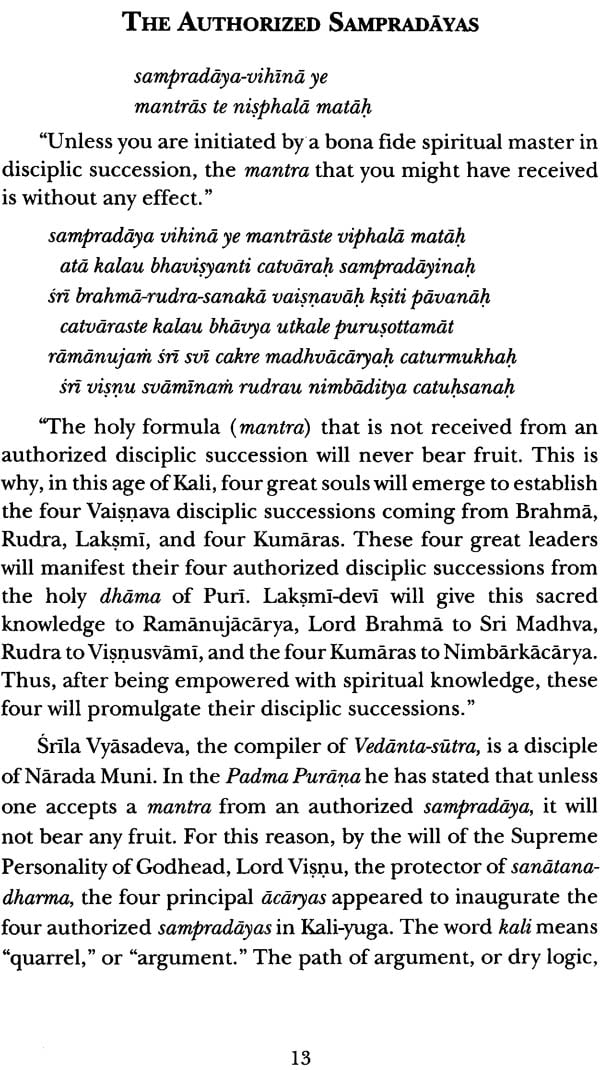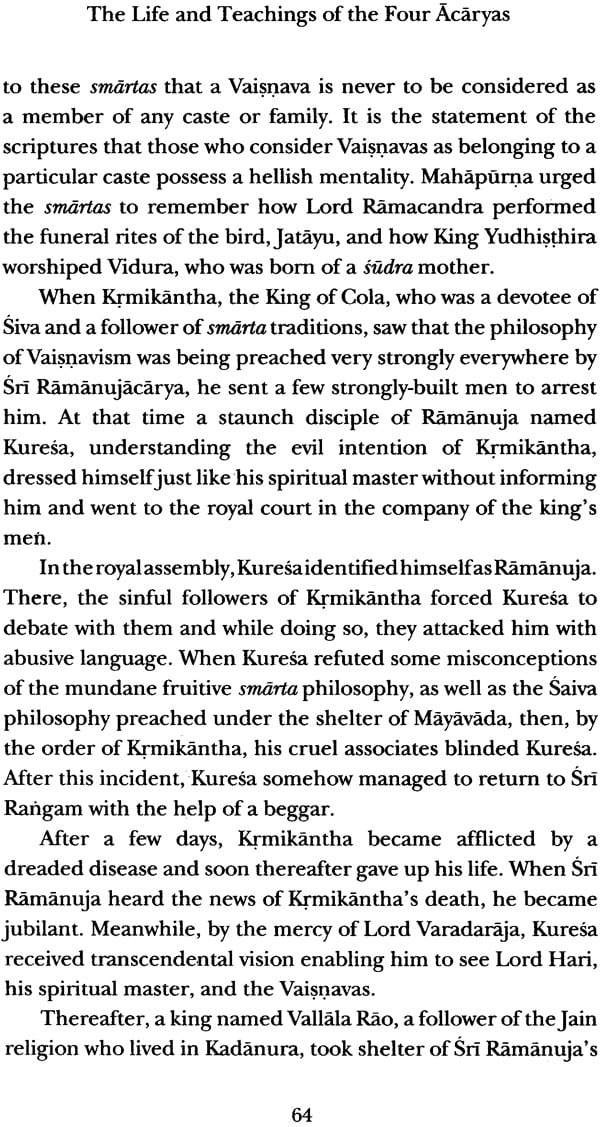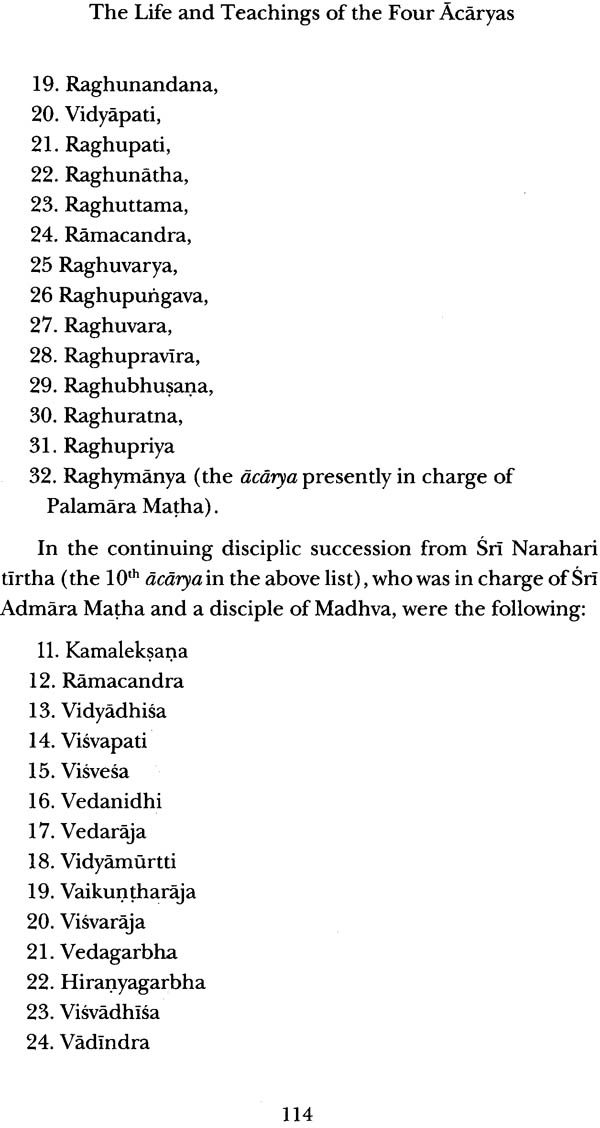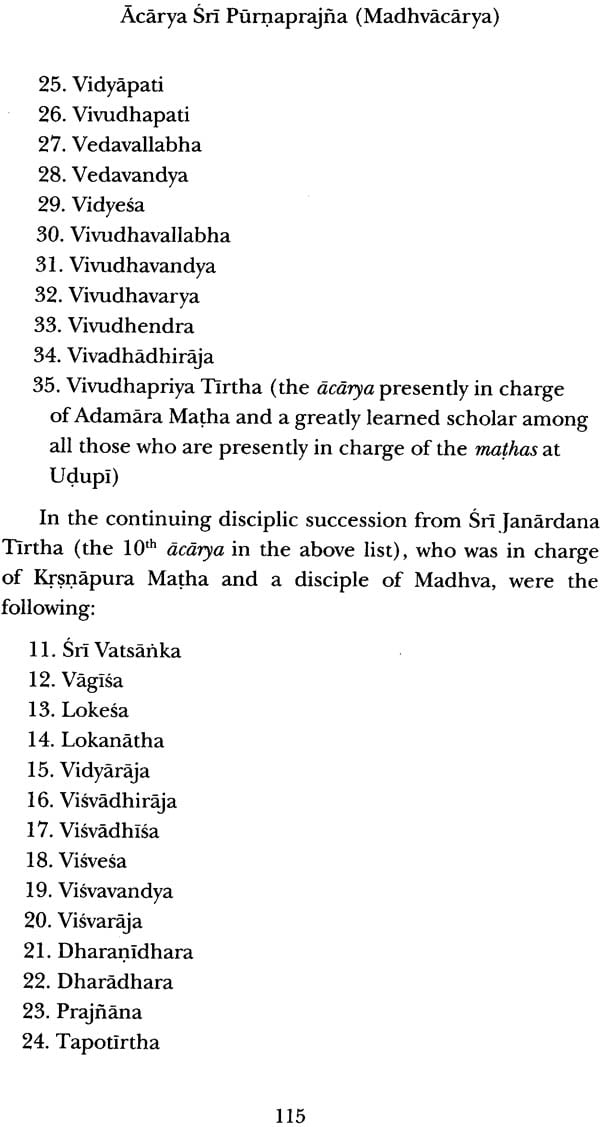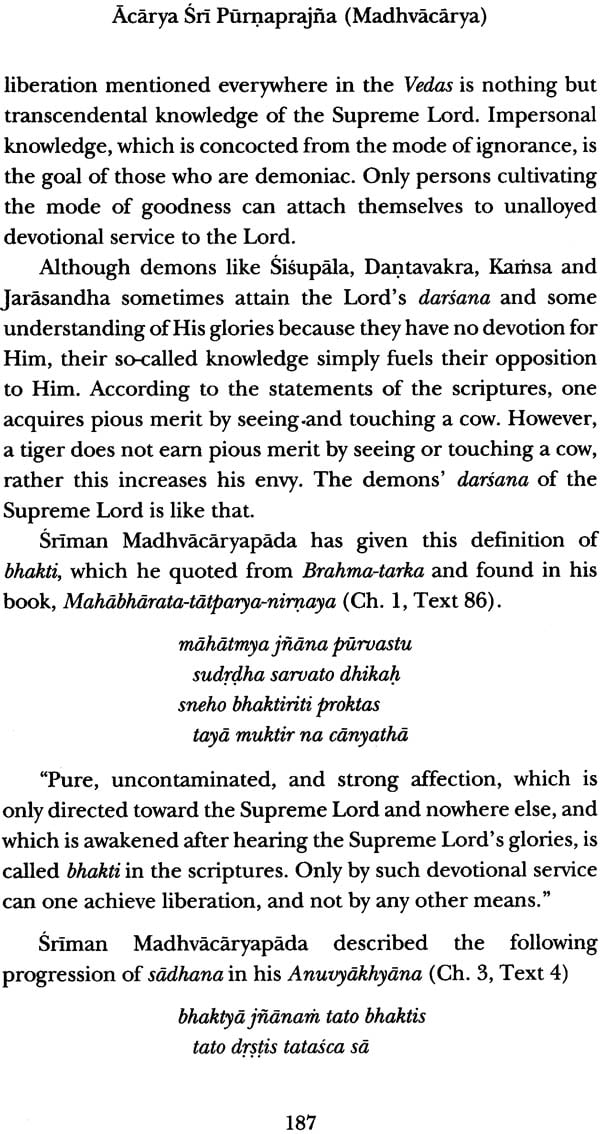
The Life and Teachings of the Four Acaryas
Book Specification
| Item Code: | NAD187 |
| Author: | Srila Bhakisiddhants Sarasvati Gosvamii |
| Publisher: | Jai Nitai Press |
| Language: | English |
| Edition: | 2015 |
| Pages: | 205 |
| Cover: | Paperback |
| Other Details | 8.5 inch X 5.5 inch |
| Weight | 240 gm |
Book Description
Whatever love and devotion you have for chanting the holy names of the Supreme Lord, may you now have the same love and devotion for glorifying the names of His devotees.
It is with great pleasure that I present this English edition of The Life and Teachings of the Four Acharyas, which was written by Srila Bhaktisiddhanta Sarasvati Gosvami in the form of articles. I pray that this presentation will be accepted as a sincere attempt to glorify the four Vaisnava acarya. I first wish to thank my Godbrother, Laxman Das, for bearing the entire cost for the publication of this book, I also wish to thank Punaprajna Prabhu for editing and proofreading this book, and Kurma Rupa Prabhu for doing the layout and cover design, I thank Ananta Sakti Das for Painting the cover illustration. I also wish to thank my wife, Caitany Devi Dasi, and son, Bhakti Siddhanta Das for typing the manuscript into the computer.
We understand that the fourauthorized Vaisnava Sampradayas originated from four sources. These original sources are Lord Siva; the four Kumars, sons of Brahma; Laksmi; and Brahma. Sri Visnu Svami was the principle acarya of the sampradya, or the disciplic succession, coming from Lord Siva. The philosophy propounded by him is known as suddhadvaita-vada. Sri Nimbaditya was the principle acarya of the disciplic succession coming from the four sons of Brhma, headed by the sage Sanaka. The philosophy propounded by them is known as dvaitadvaita-veda sir Ramanuja was the principle acarya of the disciplic succession coming from Laksmi-devi, who resides in the heart of Narayana, the lord of Vaikuntha. The philosophy propounded by him is known as visistadvaita-vada Sri-Madhvacarya was the principle acarya of the disciplic succession coming from Brahma. The philosophy propounded by him is known as dvaita-vada. There are differences of opinion about the dates of the appearances of these four acraryas. We present in this book whatever information is available.
It is written in Sri caitanya-caritamrta that when sri Caitany Mahaprabhu traveled to south India, he had a discussion with a Vaisnava of the Sri-sampradaya named sri Venkata Bhatta, at Sri Rangam. The son of Venkata Bhatta left home and received the Gaudiya Vaisnava philosophy from Sri Caitanay Mahaprabhu at Sri purusottama-ksetra. Thereafter, on the order of Lord Caitanya, he spent his remaining days in Vrndavana in the association of the Lord’s dearest associates, Sri Rupa and sri sanatana ,and was known as one of the six Gosvamis, ‘sri Gopala Bhatta Gosvami.
His great contribution was to collect and present scriptural evidence for Hari-Bhakti-Vilasa, which was compiled by sri Santana Gosvami. It is because of him that some influence of the path of devotional service in regulative principle as followed by the Sri Ramanuja Sampradaya entered the Gaudiya Vaisnava Sociey. Sri Gopal Bhatta Gosvmi’s uncle, Sri Prabodhananda Sarsvati, also resided in Vrndavana and composed many literatures, including Sri Caitanya –sondramrtam, sri Navadvipadhama-satakam, and sri Radha-rasa-sudha –nidhi.
During Sri Caitanya Mahaprabhu’s south Indian tour he visited Udupi, the headquarters of Sri Madhva smpradaya, and had a discussion with the acaryas there. Later on, while Lord Caitanay was at Jagannatha puri, sri Vallabhacarya went there for the second time and met him. At that time, due to his pride, vallabhacarya refused to accept Sridhara svami’s commentary on srimad –Bhagavatam, claiming that his own commentary was superior. However, Sri Caitanya Mahaprabhu cut down his false pride.
Sridhara Svami was a supporter of Sri Visnu Svami’s philosophy of suddhadvaita-vada. Apart from this incident regarding Lord Caitanya and Vallabhacary, we have no information of sri Caitanya Mahaprabhu’s meeting any followers of Sri Visnu Svami or Sri Nimbaditya.
In his sat-sandarbha, sri jiva Gosvami freguently quoted portions of Sardhara svami’s commentary on srimod-Bhagavatam. Later on, sri Visvanatha Cakravarti Thakura quoted some portions of Sridhara Svami’s commentary in his own commentary on srimad-bhagvatam. Although his predecessor, Sir Baladeva Vidyabhusana Prabhu, in his Govida-bhasya commentary on Vedanta-sutra, frequently quoted the writings of acaryas of the Sri madhava Sampradaya, his commentary was primarily based on the teaching of Sri Caitanya Mahaprabhu and his disciples, the six Gosvamis, which strongly establish the Philosophy of acintya-bhedabheda.
Sri Baladeva Vidyabhusana Prabhu had first referred to the Gaudiya Vaisnava Sampradaya as the Brahma-Madhva-Gaudiya sampradaya in his book prameya Ratnavali. For this reason many people mistakenly think that sri Balaeva Vidhyabhusana Prabhu is the one who first identified the Gaudiya Vaisnava sampradaya with the Madhva sampradaya. However, this is not a fact.
Sri Gadadhara Pandita’s disciple was sri Gopala Guru Gosvami, and his disciple, Sri Dhyanacandra Gosvami, accepted the Brahma-Madhava- -Gaudiya sampradaya. Although Sri Caitanay Mahaprabhu is the combined form of Radha and krsna, he took initiation from Sri Isvara Puri, a tridandi sannyasi of the Madhva sampradaya. Srila Vyasadeva had written in the padma Purana that unless one formally accepts initiation in one of the four authorized sampradayas, his chanting of mantras would not yield any result. It is for this reason that the Gaudiya Vaisnavas don’thesitate to identify themselves as members of the Brahma-Madhva-Gaudiya sampradaya.
The people of Bengal were generally ignorant of the four Vaisnava sampradayas until Sri Bhaktivinoda Thakura wrote some essays about them in his Sajjana-tosani magazine. After him, Sri Bhaktisiddanta Saravati Gosvami Thakura established sri Caitanay Matha at Sri Caiitanay Mahaprabhu’s birthplace in Sridham Mayapur, and also sixty-four gaudiya Mathas throuthout India. Among them the Matha at Dhaka was named Sri Madhva Gaudiya Matha. Moreover, in the original Sri Caitanya Matha, Sri Bhaktisiddanta Sarswati not only installed Deitis of Sri Sri radha krsna and Sri Caitanay Mahaprabhu, but in the four corners of the temple he also installed four deities of the four acaryas, as well as deities of their founders; Sri Laksmi Sri Brahma, Sri Sadasiva and Sri Catuhsana. Srila Bhaktisiddhanta Sarasvati Thakur has elaborately discussed the four sampradayas in the essays that form the basis of this book
| The Unique Position of an Acarya | 1 |
| The Authorized Sampradayas | 13 |
| Acarya Sri Visnusvami | 19 |
| The Siddhanta Preached by Sri Visnusvami | 25 |
| Visnusvai’s Siddhanta concerning the Living Entities | 25 |
| Sri Visnusvami’s Siddhanta Regarding the Material World | 27 |
| Sri Visnusvami’s Siddhanta Regarding the Supreme Lord | 29 |
| Acarya Sri Nimbaditya | 32 |
| The Mathas Established by the Nimbarka Sampradya | 36 |
| The Code of Conduct in the Nimbarka Sampradya | 39 |
| The Siddhanta Preached by Sri Nimbaditya | 39 |
| Siddhanta Regarding the Individual Living Entities | 41 |
| Siddhanta Regarding the Material World | 43 |
| Siddhanta Regarding the Supreme Lord | 43 |
| The Process of Worship in the NImbarka Sampradaya | 44 |
| Acarya Sri Ramanuja | 47 |
| The Holy Places of the Sri Sampradaya | 68 |
| The Disciplic Successions of the Visistadvaita Sampradaya | 68 |
| The Visistadvaita Philosophy | 70 |
| Sri Ramanuja’s Philosophy in Brief | 72 |
| Sri Ramanuja’s Siddhanta Regarding Spirit | 72 |
| Sri Ramanuja’s Siddhanta Regarding Matter | 76 |
| Sri Ramanuja’s Siddhanta Regarding the Supreme Lord | 76 |
| The Understanding of Parinama –vada | 78 |
| The Process of Worship According to Sri Ramanuja | 79 |
| The Five Type of Worship | 80 |
| The Ultimate Goal of Life According to Sri Ramanuja | 80 |
| A few Instructions of Sri Ramanujacarya | 82 |
| The Disciplic Succession of the Visistadvaita Sampradya | 87 |
| Acarya Sri Purnaprajna(Madhvacarya) | 91 |
| The Disiplic Succession and Mathas | 110 |
| The pairs of dvandva mathas | 121 |
| Acaryas in the disciplic succession from Sri Madhva | 122 |
| Ascertaining the date of Madhvacarya’s Apperance | 130 |
| Sri Madhva is the Third Incarnation of Vayudeva | 133 |
| Sri Madhva’s Siddhanta in Brief | 141 |
| According to Madhvacarya (Tattvaviveka adi-sloka | 144 |
| Creation and destruction | 151 |
| The conclusion regarding Laksmi | 154 |
| The Material World is Real | 158 |
| Five Categories of Distinction | 163 |
| The Distinction among Living Entities | 164 |
| The Conditioned Living Entities | 164 |
| The Liberated living Entities | 164 |
| Distinction between the Lord and the Material World | 165 |
| Distinction between Living Entities and Material World | 165 |
| The Distinction between products of Matter | 166 |
| Evidence Regarding these Distinctions | 166 |
| Sri Madhva’s Siddhanta Regarding the Living Entities | 168 |
| Siddhanta Regarding the position of the Living Entities | 171 |
| Siddhanta Regarding the Number of Living Entities | 173 |
| Living Entities’ Bondage to the Law of Karma | 173 |
| Siddhanta regarding the nature of the living entities | 175 |
| Sri Madhva’s Siddhanta Regarding Mukti, or Liberation | 184 |
| Pure Devotional Service is the Means to Attain Liberation | 186 |
| The three kinds of Evidence | 188 |
